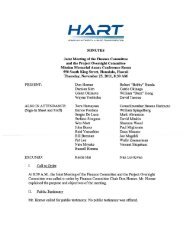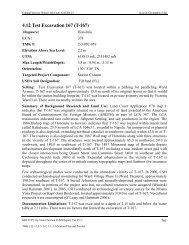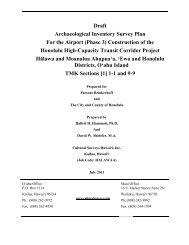AISP Kamehameha Highway Guideway - Honolulu Rail Transit Project
AISP Kamehameha Highway Guideway - Honolulu Rail Transit Project
AISP Kamehameha Highway Guideway - Honolulu Rail Transit Project
Create successful ePaper yourself
Turn your PDF publications into a flip-book with our unique Google optimized e-Paper software.
Cultural Surveys Hawai‘i Job Code: MANANA 1<br />
Background Research<br />
The eel whistled again so loudly that the children heard him and went away. The<br />
father remained to see if a shark would appear. A little while later he saw the dark<br />
form of a big shark swim about in the pool.<br />
So it was that ever after, a whistle was a signal of danger.<br />
This is the story of Pilimoo pool [Namau 1940, cited in Sterling and Summers<br />
1978:16-17].<br />
Pearl City Stone<br />
The “Pearl City Stone” myth tells of a “supernatural” rock that was located at the site of the<br />
Pearl City Mormon Church:<br />
When the church was built the stone remained undisturbed until some of the<br />
Hawaiians began to talk about it and call the attention of the visitors to this<br />
“female” rock. True, it was regarded as a sacred rock by the ancients but no one<br />
was worried about it in particular except to stare at it in curiosity and think what it<br />
must have meant to their ancestors.<br />
Then some of the “higher ups” in the church heard it. These were Hawaiians who<br />
looked upon anything that the ancients revered as detrimental to their own faith<br />
when brought in such close contact as this. They insisted that it be thrown out to<br />
the road side.<br />
Waiwaiole, a man who lived in the neighborhood and knew the legend of this<br />
rock was assigned the work of removing it to the roadside. He put it off from<br />
week to week as he hoped that his friends would forget about it, but they did not.<br />
They became more insistant until he found some one to help him to carry it out.<br />
At first he tried to lift it but it would not move until he talked to it. He told it that<br />
it was unwelcome in the church yard and it would be better for it to be by the<br />
roadside. After that, the two men had no trouble in moving it.<br />
Some years later the road was widened where the stone stood and it was blasted.<br />
Part of it is gone and a part remains to this day.<br />
Waiwaiole, the man who removed it fell sick and gradually grew worse until he<br />
was brought to the Queen’s Hospital where he died.<br />
The man who helped him also became sick with a disease that made him look<br />
bloated and dark. He became an inmate of the Mino‘aka Home until death took<br />
him. Waiwaiole’s beautiful home was burned down with fire. No one knew what<br />
caused it. His widow is still at Pearl City and expects to build a new home ere<br />
long. [Naumau 1940, cited in Sterling and Summers 1978:17]<br />
Pōhaku Anae<br />
The following story describes a famous stone in Pearl City associated with the mullet of Pearl<br />
Harbor:<br />
Archaeological Inventory Survey Plan, HHCTCP Construction Phase II, Waiawa, Mānana, Waimano, Waiau,<br />
Waimalu, Kalauao, ‘Aiea, and Hālawa Ahupua‘a, ‘Ewa District, Island of O‘ahu<br />
TMK[1] 9-7, 9-8, and 9-9 - Various Plats and Parcels<br />
30

















